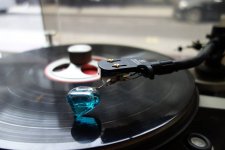A good example of being "let down" - last audio show, an Accuphase unit hooked up to a pricey JBL horn effort for the consumer. A bit of volume - oh, dear! 🙄 ... no excuses for this, the speaker had admirable sensitivity - so why the pub, midfi sound ??Accuphase is locally taken as true High End, even if they do have cheaper models as well as damn expensive ones simply because the cost of a new Accuphase model would require about a year's inome at average salaries locally.
Yes, that sort of thing. Items obviously well made and thought out which ultimately fail to deliver memorable sound.
Quantum hearing
I've done some agonising on the advisibility of raising this, but...
They think that smell is in part a quantum phenomenon.
This is prompted by chemicals having the same smell and different shapes. This has raised problems with the existing lock-and-key model of smell which has been around for a while, and is still thought to take a significant part in proceedings. Two similar smells taken were cyanide and oil of almonds.
These have radically different sizes, but they share resonant frequencies in their bonds.
In order to test this they trained a load of fruit flies to follow a smell, then they substituted deuterium for hydrogen in whatever they were smelling, and the fruit flies lost the trail. So there must have been some other clue, because both molecules fit the same lock.
Anyway they (they) think that the resonant frequency is detected by injecting an entangled electron into the molecule being smelled. Don't push me on this one, I don't know what part the other entangled electron plays.
This raises the horrific spectre of quantum hearing. If QE is involved in smell then who knows, it could be involved in hearing.
I offer no explanation as to how, but I'm sure it won't take some inventive subjectivist long.
I've done some agonising on the advisibility of raising this, but...
They think that smell is in part a quantum phenomenon.
This is prompted by chemicals having the same smell and different shapes. This has raised problems with the existing lock-and-key model of smell which has been around for a while, and is still thought to take a significant part in proceedings. Two similar smells taken were cyanide and oil of almonds.
These have radically different sizes, but they share resonant frequencies in their bonds.
In order to test this they trained a load of fruit flies to follow a smell, then they substituted deuterium for hydrogen in whatever they were smelling, and the fruit flies lost the trail. So there must have been some other clue, because both molecules fit the same lock.
Anyway they (they) think that the resonant frequency is detected by injecting an entangled electron into the molecule being smelled. Don't push me on this one, I don't know what part the other entangled electron plays.
This raises the horrific spectre of quantum hearing. If QE is involved in smell then who knows, it could be involved in hearing.
I offer no explanation as to how, but I'm sure it won't take some inventive subjectivist long.
. . . Maybe it's not QE but just the brains inability to differentiate between certain lock and key combos.
I mean, who goes around sniffing cyanide, almonds and that deuterenium stuff ? Our sense of smell is designed to help us tell apples from oranges, excrement from chocolate cake and so forth.
I mean, who goes around sniffing cyanide, almonds and that deuterenium stuff ? Our sense of smell is designed to help us tell apples from oranges, excrement from chocolate cake and so forth.
Been reading Luca Turin by any chance? One of my heroes 🙂
Ah no, nothing so exotic. I might now, recommend one please.
Just a longstanding interest in the nature of reality that predates even drinking the coolaid.
I mean, who goes around sniffing ... that deuterenium stuff ?
Fruit flies. Didn't I make that clear?
Anybody know how to generate a true 1/f noise signal, going down to sub Hz frequencies ?.
Dan.
Excess noise of a truly horrible resistor. I published this years ago but can no longer find bad enough resistors. The idea was to make a Wheatstone bridge of four of them and using an in-amp at high gain trim for 0 DC, but there is no limit on the low frequency end in this configuration.
Last edited:
Try some very, very small SMT (say 0402) thick film ones with high values (>22k). They should be admirably dismal.
Anybody know how to generate a true 1/f noise signal, going down to sub Hz frequencies ?.
How about white noise through a low gain op amp integrator? There are digital noise generator circuits that could be run slowly enough.
Last edited:
That's not 1/f.How about white noise through a low gain op amp integrator?
That's not 1/f.
Right, that would be just amplitude. MATLAB can do this.
COLORED_NOISE - 1/F^alpha Power Law Noise Generation
Would you mind to display some numbers, for us to see how "lowered skin affects" would improve transfer of high audio frequencies.
A lower Z at the surface will reduce the ac/dc ratio. Plotted, it is a flat Z to a higher freq before the increased Z starts to reassert itself.
[BTW - I have never listened to anything with the ByBee thingy in the system.]
THx-RNMarsh
Last edited:
An illustration, what No Compromise means. Enjoy! 🙂
Is that a Bybee crystal? 😀
Thanks for that image, I may never stop giggling.
- Status
- Not open for further replies.
- Home
- Member Areas
- The Lounge
- John Curl's Blowtorch preamplifier part II
